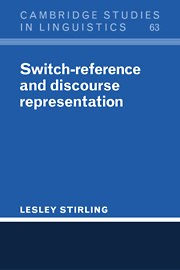Description
Switch-Reference and Discourse Representation
Cambridge Studies in Linguistics Series
Author: Stirling Lesley
This book argues that types of anaphoric linkage across clause boundaries cannot be adequately accounted for by Binding Theory, proposing instead an account for them which is formalised in Discourse Representation Theory.
Language: English
Subject for Switch-Reference and Discourse Representation:
Approximative price 53.83 €
Subject to availability at the publisher.
Add to cart
Publication date: 11-2005
372 p. · 15.2x22.8 cm · Paperback
372 p. · 15.2x22.8 cm · Paperback
Description
/li>Contents
/li>
In central cases of switch-reference, a marker on the verb of one clause is used to indicate whether its subject has the same or different reference from the subject of an adjacent, syntactically related clause. In central cases of logophoricity, a special pronoun form is used within a reported speech context, to indicate coherence with the source of reported speech. Lesley Stirling argues that these types of anaphoric linkage across clause boundaries cannot be adequately accounted for by Binding Theory. Her detailed examination of the two phenomena, including a case study of the Papuan language Amele, proposes an account for them which is formalized in Discourse Representation Theory, and explores how far it is possible for such an account to be compositional morpho-syntactic/semantic, while at the same time taking seriously the range of linguistic and cross-linguistic data to be explained. Switch-reference's indication of agreement or disagreement between clauses (or larger discourse units) is shown to function along various parameters contributing to discourse continuity: their major protagonists, spatial and temporal location, and their status as describing actual or non-actual situations. The arguments bear also on general debates around the nature of linguistically marked referential relations and the analysis of logophoric phenomena.
Preface; List of Abbreviations; 1. Switch-reference phenomena; 2. Functional extensions of switch-reference systems; 3. Theoretical conceptions of switch-reference; 4. Discourse representation theory and unification categorial grammar; 5. A discourse representation theory account of switch-reference; 6. Logophoricity; Notes; References; Index.
© 2024 LAVOISIER S.A.S.
These books may interest you

Prominent Internal Possessors 120.27 €



